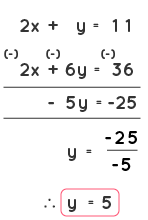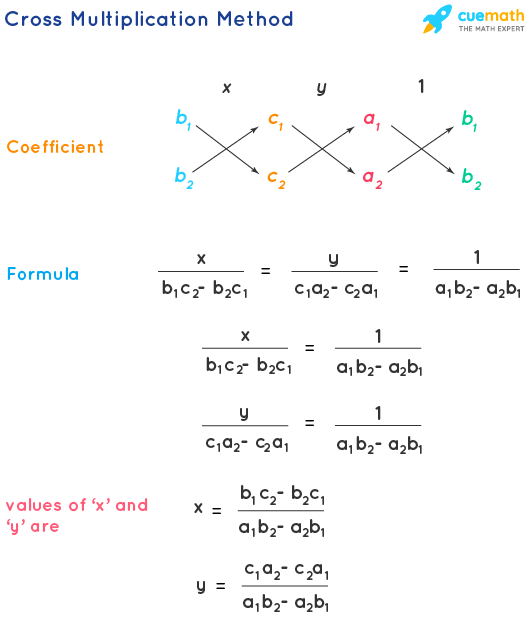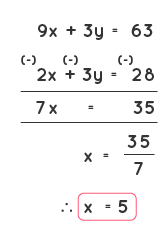How To Find A Linear Equation From A Table
Solving Linear Equations
Solving linear equations means finding the value of the variable(s) given in the linear equations. A linear equation is a combination of an algebraic expression and an equal to (=) symbol. Information technology has a caste of 1 or it tin be called a first-degree equation. For example, x + y = iv is a linear equation. Sometimes, nosotros may have to find the values of variables involved in a linear equation. When we are given two or more such linear equations, we can find the values of each variable by solving linear equations. There are a few methods to solve linear equations. Allow us discuss each of these methods in detail.
| 1. | Solving Linear Equations in I Variable |
| 2. | Solving Linear Equations by Substitution Method |
| iii. | Solving Linear Equations by Elimination Method |
| 4. | Graphical Method of Solving Linear Equations |
| five. | Cross Multiplication Method |
| half dozen. | FAQs on Solving Linear Equations |
Solving Linear Equations in I Variable
A linear equation in one variable is an equation of degree i and has only 1 variable term. It is of the form 'ax+b = 0', where 'a' is a not zip number and 'ten' is a variable. By solving linear equations in one variable, we go only one solution for the given variable. An example for this is 3x - half dozen = 0. The variable 'x' has but one solution, which is calculated as
3x - 6 = 0
3x = 6
x = half-dozen/3
ten = ii
For solving linear equations with 1 variable, simplify the equation such that all the variable terms are brought to one side and the abiding value is brought to the other side. If there are whatever fractional terms then find the LCM (Least Common Multiple) and simplify them such that the variable terms are on one side and the constant terms are on the other side. Let usa work out a pocket-size example to understand this.
4x + 8 = 8x - 10. To observe the value of 'x', let united states of america simplify and bring the 'x' terms to one side and the constant terms to some other side.
4x - 8x = -x - viii
-4x = -18
4x = 18
10 = 18/4
On simplifying, nosotros get 10 = nine/ii.
Solving Linear Equations past Substitution Method
The substitution method is 1 of the methods of solving linear equations. In the substitution method, we rearrange the equation such that one of the values is substituted in the 2nd equation. Now that we are left with an equation that has only 1 variable, nosotros can solve it and observe the value of that variable. In the 2 given equations, any equation can be taken and the value of a variable tin can be constitute and substituted in another equation. For solving linear equations using the commutation method, follow the steps mentioned below. Allow u.s.a. sympathize this with an example of solving the post-obit system of linear equations.
ten + y = six --------------(one)
2x + 4y = 20 -----------(2)
Step i: Find the value of ane of the variables using any one of the equations. In this example, let united states of america observe the value of '10' from equation (one).
10 + y = 6 ---------(1)
x = 6 - y
Pace 2: Substitute the value of the variable institute in pace 1 in the second linear equation. Now, let us substitute the value of 'x' in the second equation 2x + 4y = 20.
x = 6 - y
Substituting the value of 'x' in 2x + 4y = 20, we go,
two(vi - y) + 4y = twenty
12 - 2y + 4y = 20
12 + 2y = 20
2y = twenty - 12
2y = 8
y = 8/two
y = 4
Step 3: Now substitute the value of 'y' in either equation (1) or (2). Let us substitute the value of 'y' in equation (1).
10 + y = half-dozen
x + 4 = half dozen
x = six - 4
ten = ii
Therefore, by substitution method, the linear equations are solved, and the value of 10 is 2 and y is 4.
Solving Linear Equations past Elimination Method
The elimination method is another fashion to solve a system of linear equations. Hither we brand an attempt to multiply either the '10' variable term or the 'y' variable term with a constant value such that either the 'x' variable terms or the 'y' variable terms abolish out and gives us the value of the other variable. Let us empathise the steps of solving linear equations by elimination method. Consider the given linear equations:
2x + y = 11 ----------- (1)
x + 3y = 18 ---------- (2)
Step one: Cheque whether the terms are arranged in a way such that the '10' term is followed by a 'y' term and an equal to sign and after the equal to sign the abiding term should be present. The given set of linear equations are already arranged in the correct fashion which is ax+past=c or ax+by-c=0.
Step two: The next step is to multiply either one or both the equations by a constant value such that it volition make either the 'ten' terms or the 'y' terms cancel out which would help united states of america detect the value of the other variable. Now in equation (2), let us multiply every term by the number 2 to make the coefficients of x the same in both the equations.
ten + 3y = 18 ---------- (2)
Multiplying all the terms in equation (2) by 2, we get,
ii(ten) + 2(3y) = 2(18). Now equation (2) becomes,
2x + 6y = 36 -----------(2)
Footstep 3: The side by side step is to simplify these two equations by calculation or subtracting them (whichever operation is required to cancel the x terms). Now, by subtracting the ii equations, we can cancel out the 'x' terms in both equations.

Therefore, y = v.
Step 4: Using the value obtained in footstep 3, observe out the value of another variable past substituting the value in any of the equations. Allow us substitute the value of 'y' in equation (i). Nosotros get,
2x + y = 11
2x + 5 = xi
2x = 11 - 5
2x = 6
x = 6/2
ten = 3
Therefore, past solving linear equations, we get the value of x = 3 and y = five.
Graphical Method of Solving Linear Equations
Another method for solving linear equations is by using the graph. When we are given a system of linear equations, we graph both the equations by finding values for 'y' for dissimilar values of 'x' in the coordinate organization. Once it is done, we find the point of intersection of these two lines. The (x,y) values at the bespeak of intersection give the solution for these linear equations. Let us have 2 linear equations and solve them using the graphical method.
x + y = 8 -------(1)
y = x + 2 --------(two)
Let us take some values for 'x' and find the values for 'y' for the equation x + y = 8. This tin can also exist rewritten as y = 8 - 10.
| x | 0 | 1 | 2 | three | iv |
| y | eight | 7 | 6 | 5 | iv |
Let usa accept some values for 'ten' and find the values for 'y' in the equation y = x + ii.
| 10 | 0 | ane | 2 | 3 | 4 |
| y | two | 3 | 4 | five | 6 |
Plotting these points on the coordinate airplane, nosotros get a graph like this.

Now, we observe the point of intersection of these lines to find the values of 'x' and 'y'. The 2 lines intersect at the point (iii,5). Therefore, x = 3 and y = 5 by using the graphical method of solving linear equations.
This method is also used to discover the optimal solution of linear programming problems. Let us await at ane more method of solving linear equations, which is the cross multiplication method.
Cantankerous Multiplication Method of Solving Linear Equations
The cross multiplication method enables us to solve linear equations by picking the coefficients of all the terms ('x' , 'y' and the constant terms) in the format shown below and apply the formula for finding the values of '10' and 'y'.

Topics Related to Solving Linear Equations
Check the given articles related to solving linear equations.
- Linear Equations
- Application of Linear Equations
- Two-Variable Linear Equations
- Linear Equations and Half Planes
- Ane Variable Linear Equations and Inequations
Solving Linear Equations Examples
go to slidego to slidego to slide

Breakdown tough concepts through simple visuals.
Math will no longer be a tough subject area, peculiarly when you sympathize the concepts through visualizations.
Book a Gratuitous Trial Course
Practice Questions on Solving Linear Equations
become to slidego to slidego to slide
FAQs on Solving Linear Equations
What does it Mean by Solving Linear Equations?
An equation that has a degree of 1 is chosen a linear equation. Nosotros can have one variable linear equations, two-variable linear equations, linear equations with three variables, and more than depending on the number of variables in it. Solving linear equations ways finding the values of all the variables nowadays in the equation. This can be done past substitution method, emptying method, graphical method, and the cross multiplication method. All these methods are different ways of finding the values of the variables.
How to Use the Commutation Method for Solving Linear Equations?
The substitution method of solving equations states that for a given organisation of linear equations, notice the value of either 'x' or 'y' from any of the given equations and then substitute the value found of '10' or 'y' in some other equation so that the other unknown value can exist found.
How to Apply the Emptying Method for Solving Linear Equations?
In the elimination method of solving linear equations, we multiply a constant or a number with one equation or both the equations such that either the 'x' terms or the 'y' terms are the same. Then we cancel out the aforementioned term in both the equations by either adding or subtracting them and notice the value of ane variable (either 'x' or 'y'). Later finding one of the values, we substitute the value in one of the equations and find the other unknown value.
What is the Graphical Method of Solving Linear Equations?
In the graphical method of solving linear equations, we observe the value of 'y' from the given equations by putting the values of x as 0, ane, 2, three, and so on, and plot a graph in the coordinate organization for the line for various values of 'x' for both the system of linear equations. We will see that these ii lines intersect at a signal. This point is the solution for the given system of linear equations. If at that place is no intersection point between two lines, and then we consider them as parallel lines, and if we plant that both the lines lie on each other, those are known as coincident lines and have infinitely many solutions.
What are the Steps of Solving Linear Equations that has One Variable?
A linear equation is an equation with caste one. To solve a linear equation that has one variable nosotros bring the variable to 1 side and the constant value to the other side. Then, a non-cypher number may be added, subtracted, multiplied, or divided on both sides of the equation. For example, a linear equation with one variable volition be of the form 'ten - 4 = 2'. To find the value of 'ten', nosotros add together the constant value '4' to both sides of the equation. Therefore, the value of 'x = half dozen'.
What are the Steps of Solving Linear Equations having Three Variables?
To solve a system of linear equations that has three variables, nosotros take whatsoever 2 equations and variables. We then accept some other pair of linear equations and also solve for the same variable. Now that, nosotros have two linear equations with two variables, we can employ the substitution method or emptying method, or any other method to solve the values of two unknown variables. Later finding these two variables, we substitute them in whatever of the iii equations to find the third unknown variable.
What are the 4 Methods of Solving Linear Equations?
The methods for solving linear equations are given below:
- Exchange method
- Elimination method
- Cross multiplication method
- Graphical method
Source: https://www.cuemath.com/algebra/solving-linear-equations/
Posted by: parrishthicamewyn1960.blogspot.com


0 Response to "How To Find A Linear Equation From A Table"
Post a Comment